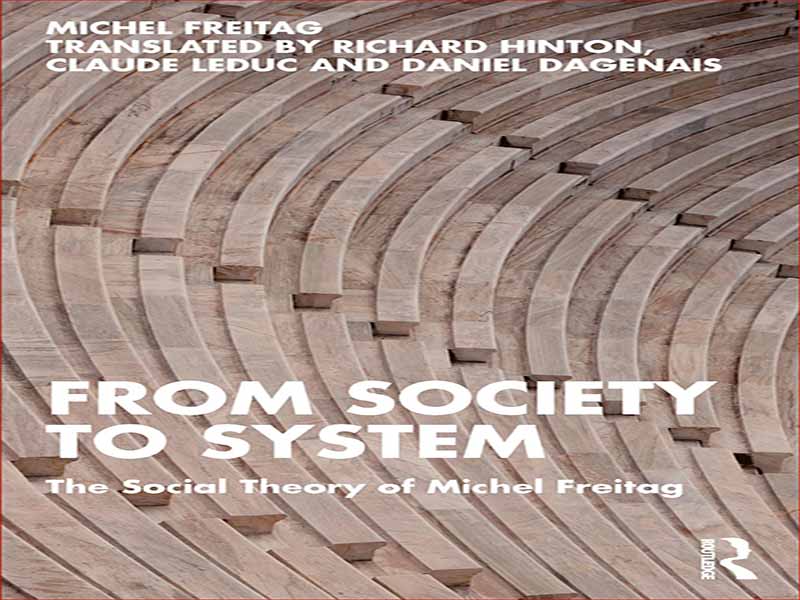- عنوان کتاب: FROM SOCIETY TO SYSTEM / The Social Theory of Michel Freitag
- نویسنده/انتشارات: Sebastian Ille
- حوزه: نظریه جامعه شناسی
- سال انتشار: 2022
- تعداد صفحه: 239
- زبان اصلی: انگلیسی
- نوع فایل: pdf
- حجم فایل: 13.2 مگابایت
با این کتاب، ما به خوانندگان انگلیسی زبان با اولین خواننده ارائه می کنیم که هدف آن ارائه یک مرور کلی از کار اصلی میشل فریتاگ، جامعه شناس است. فریتاگ که در سال 1935 در سوئیس به دنیا آمد و با آلن تورن تحصیل کرد و مدت کوتاهی قبل از مهاجرت به کبک (کانادا) در الجزایر (در زمینه معماری عمومی) کار کرد، در تأسیس دپارتمان جامعهشناسی در مرکز جدید تأسیس شد. Université du Québec à Montréal که تمام دوران حرفه ای خود را در آنجا گذراند. او در سال 2009 درگذشت، و از خود مجموع جامعهشناختی قابل توجهی را به جای گذاشت که در کنار آثار مارگارت آرچر، آنتونی گیدنز، یورگن هابرماس یا نیکلاس لومان قرار دارد و با آنها مقایسه میشود. آثار او اکنون از او باقی مانده است، به ویژه از طریق وجود یک مکتب فکری اصیل که جامعهشناسان و فیلسوفان را در کانادا و خارج از آن گرد هم میآورد، و اکنون بیشتر و بیشتر به عنوان L’École de Montréal شناخته میشود. با وجود چند مقاله منتشر شده در ترجمه، 2 قطعاً ارزش دارد که این ارائه کوتاه را با قرار دادن کار او در مقایسه با انبوهی از نظریه پردازان اجتماعی آغاز کنیم که مانند او در دهه 1980 نظریه بزرگ قابل مقایسه ای را منتشر کردند. تجدید ژانری که از زمان تالکوت پارسونز تقریباً ناپدید شده بود. برای شروع، این یک واقعیت مهم است که به مدت نیم قرن رها شده بود، حوزه نظریه های بزرگ در تصادفی قابل توجه با دوره واقعاً پس کلاسیک تجدید شد. نظریات منتشر شده، در یک بازه زمانی کوتاه. حتی پانزده سال از نظریه اجتماعی یورگن هابرماس (1981) از نظریه اجتماعی رئالیستی مارگارت آرچر: رویکرد مورفوژنتیک (1995) جدا نیست، مدت زمانی کوتاهی که شاهد انتشار چندین پروژه مشابه دیگر جامعه شناختی بودیم: Soziale نیکلاس لومان. نظریه ساختار سیستمی و آنتونی گیدنز هر دو در سال 1984 ظاهر شدند، در حالی که دیالکتیک و جامعه فریتاگ در سال 1986 توسط اولریش بک Risikogesellschaft همراه شد، البته انتشار اولیه موری بوکچین (1982) بوم شناسی آزادی را فراموش نکنیم. به اندازه کافی قابل توجه است که همه این نظریه ها ادعای اصالت و «پسا کلاسیکالیسم» دارند، چیزی که خودخواندن دیدگاه نظری خودشان گواه آن است: نظریه ساختار، نظریه سیستم ها، مورفوژنز، دیالکتیک جامعه شناسی، جامعه ریسک، بوم شناسی اجتماعی، نه به تئوری شبکه بازیگر و موارد مشابه را ذکر کنید. چگونه با هم جمع می شوند؟ شرط مشترک احتمالی آنها (تا کنون) چیست؟ چه چیزی آنها را از یکدیگر متمایز می کند؟ پاسخ آسان و سریعی برای آن وجود ندارد و در واقع بسیار گویای این است که اغلب کتابهای درسی که نمونهای از نظریههای اجتماعی معاصر را به دانشجویان ارائه میدهند، فهرستی غیر جامع از این نظریهها را انتخاب کردهاند و آنها را بر اساس موضوعات رتبهبندی کردهاند. گاهشماری، دیدگاهها یا به سادگی بر اساس نویسندگان. در حالی که هر یک از این نظریهها ادعا میکنند که در اصل عاملیت و ساختار را (باز) بیان میکنند، گویی که این مشکل نیمهدورهای جامعهشناسی است، به نظر من آنها با توجه به روشی که با جدایی احتمالی بین دو قلمرو کنار میآیند، از یکدیگر متمایز میشوند. ، به شیوه ای کاملاً غیر نظری با این واقعیت کنار می آید که جامعه بیش از پیش از افراد فرار می کند. آنچه در پس تجدید نظریات کلان جامعهشناختی نهفته است، به همان اندازه که پیچیده هستند، موضوع بیاهمیت از دست دادن احتمالی کنترل ما بر سرنوشت جامعه است که آنها به طرق مختلف پیشنهاد آشتی با آن را دارند. اجازه دهید به چند مورد از این موارد نگاه کنیم.
With this book, we are offering the English-speaking readership with the first Reader meant to provide an overview of sociologist Michel Freitag’s original work. Born in Switzerland in 1935, having studied with Alain Touraine and worked in Algeria (in the field of public architecture) shortly before emi¬grating to Québec (Canada), Freitag has been involved in the foundation of the Department of sociology at the newly created Université du Québec à Montréal where he spent his entire career. He died in 2009, leaving behind an impressive sociological sum that stands next to, and compares with, the work of Margaret Archer, Anthony Giddens, Jürgen Habermas or Niklas Luhmann, to list but a few. His work now survives him, notably through the existence of an original school of thought gathering sociologists and philosophers in Canada and abroad, and now more and more referred to as L’École de Montréal.1 Since Freitag’s writings are little known in the English-speaking academia, in spite of a few papers published in translation,2 it is certainly worth beginning this short presentation by situating his work in comparison with a host of social theorists who, as he did in the 1980s, published a comparable Grand Theory, thus renewing a genre having almost vanished away since Talcott Parsons.To begin with, it is significant a fact in itself that, having been deserted for half-a-century, the field of Grand Theories was renewed in a remarkable coincidence of truly post-classical theories published, in a short span of time.3 Consider. Not even fifteen years separate Jürgen Habermas’ Theorie des kom¬munikativen Handelns (1981) from Margaret Archer’s Realist Social Theory: The Morphogenetic Approach (1995), a short period of time having witnessed the publication of several other similar sociological projects: Niklas Luhmann’s Soziale Systeme and Anthony Giddens’ Structuration Theory both appeared in 1984, while Freitag’s Dialectique et société was accompanied in 1986 by Ulrich Beck’s Risikogesellschaft, not to forget Murray Bookchin early publication (1982) of The Ecology of Freedom. Significantly enough, all these theories claim for originality and “post-classicalism”, something to which the self-christening of their own theoretical perspective testifies to: Structuration Theory, Systems Theory, Morphogenesis, Sociologie dialectique, Risk society, Social Ecology, not to mention Actor Network Theory and the likes. How do they come together? What is (has been) their common condi¬tion of possibility? What distinguishes them from one another? There is no easy and quick answer to that and it is very telling indeed that most of the textbooks presenting undergraduate students with a sample of contemporary social theories, have opted for a non-comprehensive list of such theories, rank¬ing them by topics, chronology, perspectives or simply according to authors. While each of these theories claims to (re)articulate originally agency and structure, as if it were sociology’s sempiternal problem, it seems to me that they distinguish from one another according to the way they come to terms with the possible disjunction between the two realms, coming to terms in an abso¬lutely non-theoretical way with the fact that society escapes individuals more and more. What lies behind the renewal of grand sociological theories, as sophisticated as they are, is the trivial issue of our possible loss of control over the destiny of society to which they propose to reconcile in different ways. Let us look at a few of these.
این کتاب را میتوانید از لینک زیر بصورت رایگان دانلود کنید:
Download: FROM SOCIETY TO SYSTEM



































نظرات کاربران